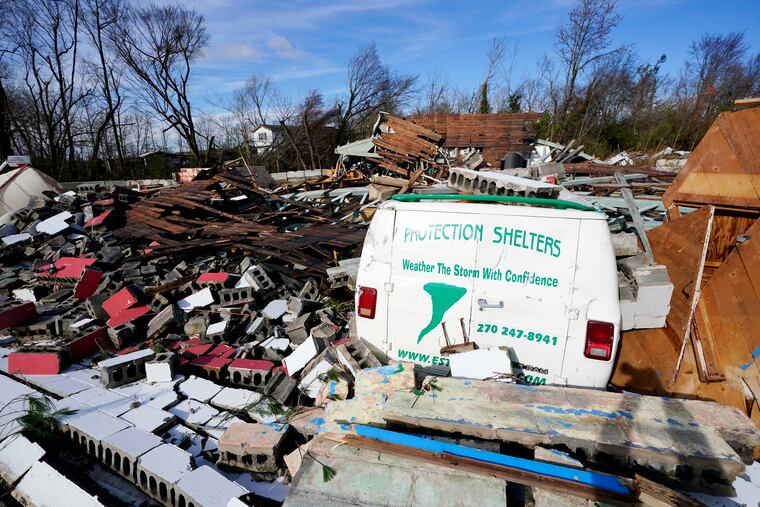Warming winds help Philly set a record - and incite a disaster in Kentucky
The timing and ferocity of the outbreak was rare. As the front moved eastward, Philadelphia set a temperature record.

Philadelphia set a high temperature record Saturday on an overcast, almost eerily balmy day that shared some similarities to Friday’s weather in southwestern Kentucky.
The temperature there made it to the low 70s on the strength of warming winds from the south, a dash of April in December that evidently had a whole lot to do with the horrors that followed.
A tornado outbreak — rare in its timing and ferocity — imposed a reign of terror in portions of five states Friday night into early Saturday, with at least 70 feared dead in Kentucky.
The level of destruction, Kentucky Gov. Andy Beshear would say at a news briefing, “was something we have never seen before,” adding that the death toll could rise to 100.
Storm surveys had not yet been completed, but Beshear said one of the tornadoes had traveled an astonishing 227 miles, the longest such path in the state’s history.
According to the government’s Storm Prediction Center, in Norman, Okla., the average path length is about 3.5 miles, and 200-plus miles would qualify for the “upper echelon” of all-time tornadic tracks, said Bill Bunting, the center’s chief of the Forecast Operations Branch.
The cold front that helped ignite the outbreak approached the Philadelphia region Saturday evening after the southerly winds had driven the temperature to a record high for the date with a peak of 67. Winds gusted past 40 mph, and a wind advisory was in effect until 1 a.m., but no widespread power outages were anticipated as the soils are dry and the trees more stable, less vulnerable, and mostly unburdened of leaves.
In other words, nothing like what happened in Kentucky, Illinois, Arkansas, Tennessee, and Missouri.
The storm center, which issues all tornado watches, logged 38 reports of tornadoes during the outbreak, but it will be days before investigators determine how many twisters actually touched, said Bunting.
The twisters were ignited in part by temperature contrasts. While it felt like April in Kentucky, it was January in Minnesota, with snow and temperatures in the 20s Friday afternoon.
» READ MORE: Tornado counts have spiked dramatically around Philly and elsewhere. Here’s what is behind the surge.
The contrast created an atmospheric minefield, said Renee Duff, a meteorologist with AccuWeather Inc. “This time of year when you have warm air starting to build, you have to be concerned.”
The clash generated the “instability” that induces warm, moist air to rise over cold air and form storms. Bunting said the instability wasn’t off the charts, but together with the shear — wind blowing at opposing directions at different levels of the atmosphere — the environment was ripened to spin up destruction.
The weather service office in Paducah, Ky., issued seven tornado warnings between 8:30 p.m. and just after midnight.
» READ MORE: Tornado rips apart buildings in Bucks County as potent storms cross Philly region
Although they can be immensely destructive, tornadoes typically slice through narrow paths. Unfortunately, on occasion they tear through developed areas.
“Often it just comes down to what’s in the path and who is in the path,” Bunting said. “Most of the time we dodge the bullets.”
In this case, the tornadoes were especially dangerous because they came at night. Most of the time they touch down in daylight, when tornado-spawning thunderstorms get an extra kick from solar energy.
“They’re moving at 60 mph, and it’s night,” Bunting said. “By the time you realize something’s approaching, it’s on you.”
While this was an extraordinary event, neither December nor nighttime tornadoes are unprecedented. Bunting referred to an especially destructive twister in the Dallas area in late December 2015.
» READ MORE: A tornado outbreak killed 64 people in Pennsylvania 35 years ago. We still know terrifyingly little about the storms.
The planet’s temperatures continue to rise, along with reports of extreme weather, but Bunting said any climate-change role in this outbreak would be difficult to identify.
“Tornadoes are sufficiently rare, and our detailed record is short,” he said. “It is hard to attribute any one particular event to climate change, especially with rare events like tornadoes. It’s not possible to say with confidence.”